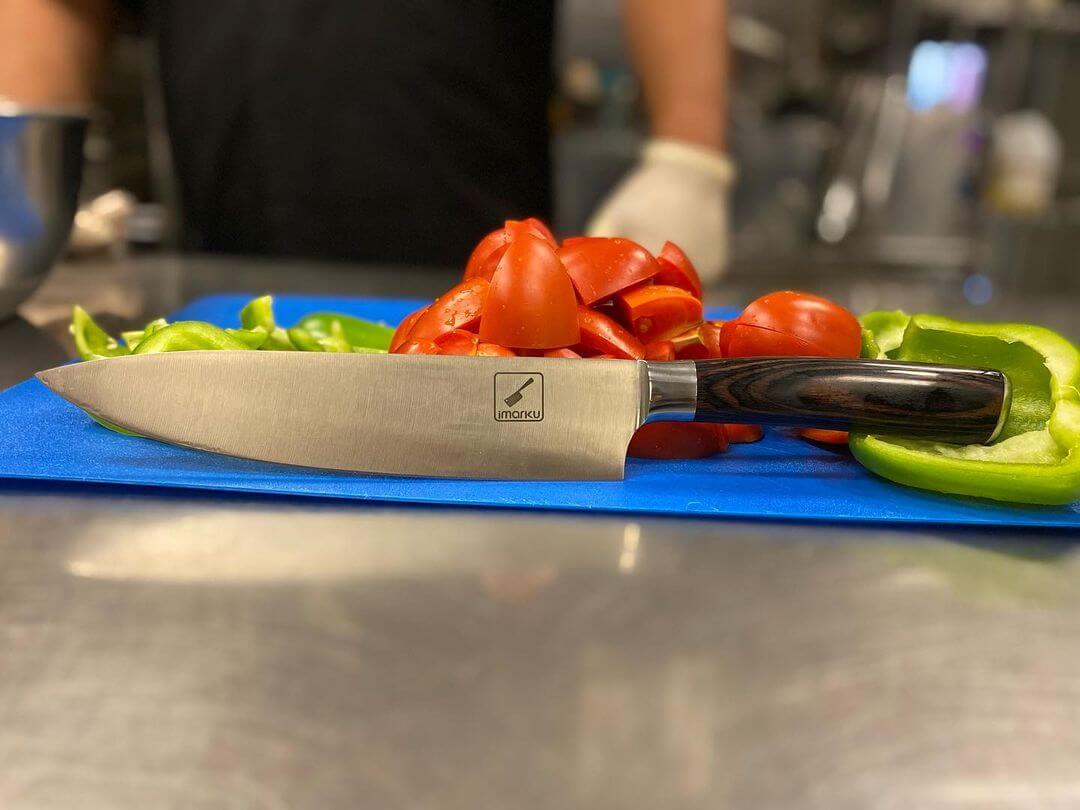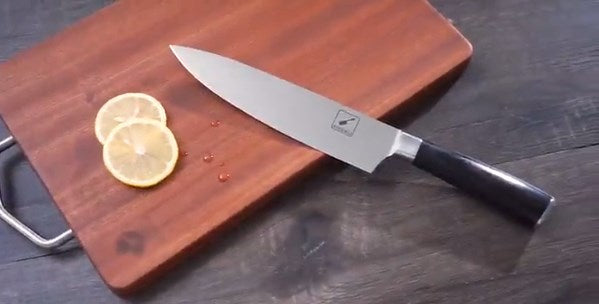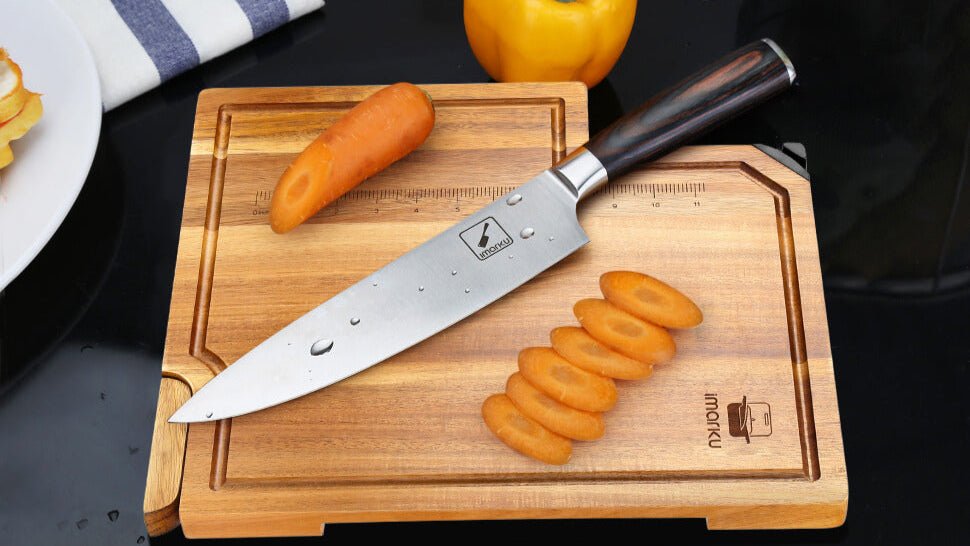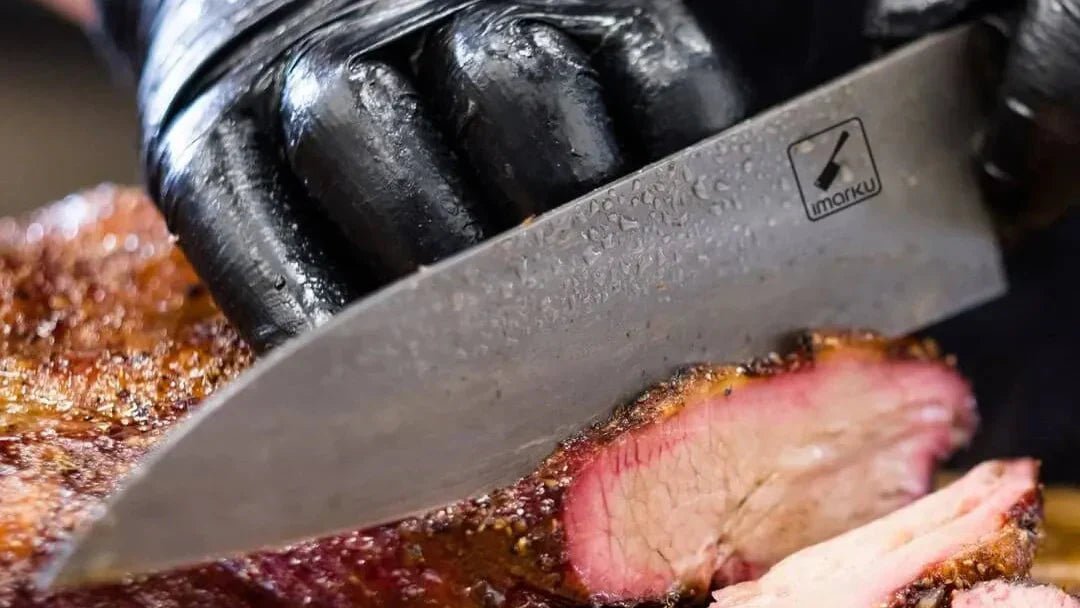TABLE OF CONTENTS
A chef's knife is the most important tool you can have in your cookery space. It is the go-to blade for most cutting tasks such as slicing fruits and vegetables, cutting meat and fish and mincing onion and garlic. Also known as the cook's knife, the chef's knife is generally agreed on by users as the kitchen's workhorse.
With a blade that's just the right size, the chefs knife purpose can do most of the cutting tasks except for carving poultry and thin-peeling fruits and vegetables such as squash. You can even do away with other types of knives, but not this one. The chef's knife is as indespensable as your right hand for essentials of your cookware area.

The Anatomy of a Chef's Knife
The chef knife can be about 6 to 12 inches in length and can be identified by the gradual upward tapering of the blade to its pointed end. The purpose of this shape is to allow the user to rock the knife back and forth for mincing conveniently. Note that the best knives are forged from a single piece of steel that spans the entire length of the blade.
The Handle
The handle plays an almost equal role as the blade's cutting edge. A correctly made handle can provide the comfort and safety that will give the chef the control and confidence to do the fast and efficient cutting and slicing. The handle contributes to his overall performance in creating good food. Handles come in many shapes and sizes, as well as material composition.
Nonetheless, a good chef's knife has a good working handle shaped to a comfortable grip. It's not slippery that may cause the cook to grip it too hard, making it unwieldy and dangerous. Chef's knives have traditionally been built with wooden handles (and they still are). However, with the advent of awareness about health and sanitation, the wooden handle has taken the flak for potential health concerns with its use.
They say that wood is porous and can harbor bacteria that cause food-related sickness. Or with regular use, wood may later sustain cracks around rivets and anywhere where wood joins the steel. Moisture, regular wear and tear could make it lose and unstable, rendering it unsafe to use.
Furthermore, wood may also warp or crack if soaked in water. Such are the limitations of wooden handles that plastic and rubber handles are becoming increasingly popular nowadays. Also, a composite of wood and plastic resin type of handle gives the knife that classic wooden handle looks minus the threat of bacterial contamination.
The Blade
This portion of the knife does its business, such as cutting, slicing, and some dicing action. The blade is generally a trademark of how well a craftsman has forged an edge that can cut well and lasts long. A knife's ability to cut effectively may depend on the shape and thickness of the handle. Also, a good blade must jive well with the rest of the parts for balance and ease of use.
Most favorably, chef's knives blades are made out of high-grade carbon stainless steel that keeps the sharp edge for a longer time and doesn't rust. A typical chef's knife blade can measure up to 6- 12 inches long from tip to handle. It features a gentle curve from the tip to the handle to sustain a smooth back-and-forth rocking motion when chopping and mincing.
Bolster
Also known as the shank, collar, or shoulder, the bolster is a thick heavy steel part where the handle and the blade meet. Its primary function is to protect your fingers from the blade as you grip the knife. Added to that, a chef's knife with a bolster is a hallmark of a blade forged from one piece of steel, unlike some that are stamped out of a roll of sheet metal.
Forged knives are better in quality compared to stamped knives. The thickness of your bolster is the original width of the piece of steel it was developed from. This thick and unsharpened portion of your blade helps you guide your hand for a proper grip.
The Tang
The tang is the final extension of the knife that runs to and through the handle. If it extends all the way to its back, it is called a "full tang" as it provides solid and balanced weight to the knife. A full tang is generally preferred over a partial tang as it is perceived to be more stable.
The Rivets
Rivets are those cylindrical studs that securely hold the handle in place on the knife's tang. You can see these mostly on wooden handle types. It's crucial that the rivets are securely fastened and are not protruding so you'd know that you are getting a quality knife.
The Heel
The heel is the widest cutting part of your chef knife, and it is located at the rear portion of your blade where it meets the handle. It is where you cut your carrots, chicken cartilage, and other items that need heavier force to slice.
The Spine
The spine is the top area located opposite the middle cutting portion of your blade. This is the part where you would sometimes put your other hand over and push down to add more force while cutting hard fruit or some small chicken bones.

German or Japanese Style?
With the making of knives becoming a universal skill, the more popular makers of chef's knives or any other knife for that matter, are the German and Japanese blade makers. They both are known for satisfaction in quality and reliability. Although, they both have their unique style that stands out from most manufactured knives. Let's go ahead and take a look at their differences.
Usability
German chef's knives focus more on utility, effectivity, and durability. They aim to perform in any condition consistently. In a way, it is built to be a workhorse. On the other hand, Japanese knives are more sophisticated in function. Designed for precise and finer cutting jobs, the Japanese knife can make cuts with such ease accuracy that it has become with many cooks enthusiasts worldwide.
On the one hand, the German blade can take abuse and even be used as a multipurpose cutting tool. The Japanese are made much thinner, although it's no softie either. It can also show some level of reliability when it comes to lasting blades.
Hardness
Measured on the Rockwell scale, the Japanese knife is much harder than the German knife. The Japanese come in at 63 maximum and the German knife at 57. Incidentally, the higher the number, the harder the blade. We may then conclude that if the Japanese blade is more rigid, it can hold an edge longer than the thicker, softer German knife.
Only that harder doesn't necessarily mean sturdier. So typically, a Japanese knife edge would be more prone to cracked blades than the German's.
Blade Angle
The blade angle determines the sharpness of a knife. The smaller the cutting path, the more precise and accurate the slice is. Considering that the Japanese blade sits around 10 to 15 degrees on each side compared to the German knife, which is wider at 17.5 degrees, it shows that the Japanese knife is preferred in this area.

How Chef Knives Are Made
Knives, in general, are made in many ways by using different composites and steel. Let's look into how some of them are made and a few of their pros and cons.
Are They Forged Or Stamped?
Wrenched out of a single bar of forged steel, a forged blade in the past could only be made by hand or assisted by simple machines. This is done by heating and folding steel while hammering it down to create a solid and sharp blade.
Today, forging can already be done by robots with little human intervention in the factory. It may still come very close to the handmade quality. All the same, Artisan's handmade knives are also available, which are fast gaining popularity among enthusiasts and cooks.
On the other hand, stamping is an inexpensive way to make a functional knife. They just laser cut a blade out of a sheet of metal and heat it to make it durable. This is in no way compared to the quality of a forged knife but still works well anyway.

High Carbon Steel Vs. Stainless Steel
Carbon and stainless steel are the most common go-to material for knife making nowadays, albeit with plus and minuses.
High Carbon Steel
It can make for a stiffer blade that can keep a sharp edge for longer periods of time, but it may also become rusty if not taken care of.
Stainless Steel
This material is highly resistant to rust and discolouration, making it easy to maintain and use. However, its chromium content adds to its durability, making the blade softer. It then requires resharpening more often than carbon steel. Stainless is also easier to sharpen and is less prone to chipping.
Other types of blades
There are lesser-known materials for blades, such as the laminated knife. It uses a combination of soft but tougher steel as inner material and harder backing material. Ceramic blades are specialty knives that can hold the longest edge. However, they chip easily and could break if accidentally dropped. They are used for cutting foods that require no metal, so the food itself doesn't discolour when cut.

How to Choose Your Kitchen Workhorse
When you want to buy your first knife or treat it as an investment, we recommend doing it in person or checking the reviews online. This way, you can know its heft, cutting power, as well as have the chance to ask an expert about its durability. For a trusted option with excellent craftsmanship and customer feedback, explore our Phantom Series knives.
Consider the following when buying your chef's knife:
Material Composition of the Blade
As discussed, you can always narrow down your material preference to high-carbon steel and or stainless steel. If you are a professional cook, you may have to get both to switch from one to the other without a hitch.
Cutting ability
Check the reviews online, or don't be shy to ask your dealer if they have a testing area for your chef's knife. Try it for size by cutting veggies, small fruits and dicing some onions. Carve a watermelon or slice a hard vegetable. If you end up feeling confident and satisfied, then you could have a winner in your hands.
Comfort
You will know immediately if a knife is comfortable to use or not. A tight grip will indicate if it will cause your hand to be sore when used for long periods.
Weight
Some cooks prefer lighter, thinner and sharper knives, while others want thicker, heavier, but no less sharp knives. Choose what works for you best.
Balance
A good balance means that holding the knife doesn't bring your hand to tilt forward or backward. It just lays there comfortably in your hand. It shouldn't lean sideways when you come down on the blade, and it should stay stable and accurate and not feel dangerous and unstable when in use.
Size
An 8-inch chef's knife is where we would be in terms of the average size of a blade. You can go for 10 inches to cut more volume if you can handle it. A 6-inch knife, on the other hand, can be too short even to cut through a large fruit like a watermelon. In any case, whatever your preference for length is, make sure it's something that you feel will work for you well.






















Leave a comment
All comments are moderated before being published.
This site is protected by hCaptcha and the hCaptcha Privacy Policy and Terms of Service apply.